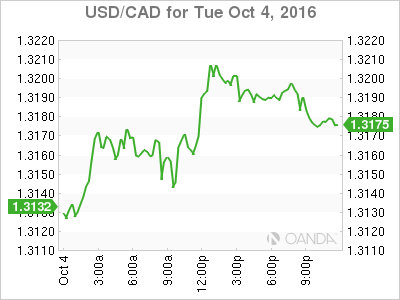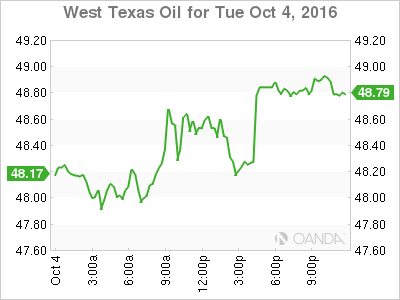The Canadian dollar fell slightly versus the U.S. dollar on Tuesday as the the oil price rally lost momentum and other commodities dropped after hawkish comments from Fed member Jeffery Lacker. The interest rate divergence that has kept the USD bid was boosted by positive economic indicators on Monday and comments from Fed members. The market will now focus on the U.S. employment data to be released starting today at 8:15 am EDT as the ADP private payrolls report is published.
The International Monetary Fund (IMF) downgraded Canadian growth forecasts to 1.2 percent in 2016 and 1.9 percent next year. The updated estimates were also lower for the U.S. which saw its growth estimates trimmed down to 1.6 percent in 2016. The outlook for the global economy remained unchanged as the downgrades were balanced with upgrades to the U.K. after it was too pessimistic on the effect of the Brexit vote in the short term. The GBP was close to a 31 year low as British PM has outlined the schedule for the eventual exit from the European Union as the government will trigger Article 50 in March, 2017.
Canadian Finance Minister couldn’t have timed his announcement to change housing rules any better. The next day after Bill Morneau announced four updates to cool down the real estate market there are signs that Vancouver home sales have dropped as some tax incentives and tougher mortgage rules will be in effect this month.
The USD/CAD lost 0.674 percent in 24 hours of trade yesterday. The pair is trading at 1.3201 after being caught between the rise of the USD and the optimistic view on oil prices based on the comments by Iran to meet with Russia ahead of the OPEC meeting in Vienna. The USD/CAD has moved from a daily low of 1.3093 up to a high of 1.3216 as oil prices are stable awaiting inventory data and the USD will get further direction from employment data in the coming days.
West Texas oil lost 0.205 percent in the last 24 hours. The price of oil is trading at $48.18 on a slightly choppy trading day in the energy sector. After the volatility of the previous week after the Organization of the Petroleum Exporting Countries (OPEC) announced a production cut combined with a drawdown in U.S. inventories sent the price of oil to near 4 month highs. Today’s weekly inventories released by the Energy Information Administration (EIA) are forecasted to show a buildup and even though the last 4 weeks have seen drawdowns.
The strength of the USD limited the gains in the oil market as other commodities suffered as the Fed appears ready to hike in December. Employment indicators will be key this week. Today’s ADP private payroll is expected to add 160,000 new jobs ahead of the main event on Friday with the release of the U.S. non farm payrolls (NFP). The NFP report has been forecasted to add around 160,000 to 180,000 jobs, but markets will be particularly keen on the wage growth component as the Fed has shifted its focus from jobs to inflation.
Gold lost 3.21 percent in the last 24 hours. The price of the precious metal is trading at $1269.40 after rhetoric from the U.S. Federal Reserve on an almost imminent interest rate rise in December coupled with lower anxiety about macro risks has gold on the back foot. The one day drop in the price of the yellow metal was the biggest in nearly three years. Silver saw a 5.33 percent depreciation as economic indicators in the U.S. and interest rate hike supportive Fed Speak have pushed the USD higher against safe haven assets.
